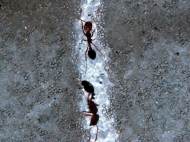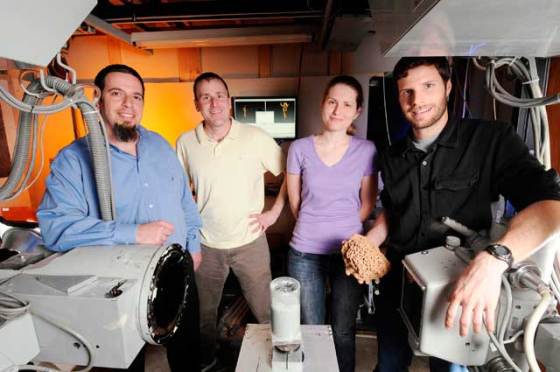Fire ants inspire principles of underground locomotion
 Georgia Institute of Technology (Georgia Tech) researchers studied fire ants to uncover fundamental principles of locomotion that could be applied on teams of robots which travel through underground tunnels. Among the study’s findings, the researchers were surprised by the first observation that ants in confined spaces use their antennae for locomotion as well as for sensing the environment.
Georgia Institute of Technology (Georgia Tech) researchers studied fire ants to uncover fundamental principles of locomotion that could be applied on teams of robots which travel through underground tunnels. Among the study’s findings, the researchers were surprised by the first observation that ants in confined spaces use their antennae for locomotion as well as for sensing the environment.
In a series of studies carried out by graduate research assistant Nick Gravish, groups of fire ants (Solenopsis invicta) were placed into tubes of soil and allowed to dig tunnels for 20 hours. To simulate a range of environmental conditions, Gravish and postdoctoral fellow Daria Monaenkova varied the size of the soil particles from 50 microns on up to 600 microns, and also altered the moisture content from 1 to 20 percent.
While the variations in particle size and moisture content did produce changes in the volume of tunnels produced and the depth that the ants dug, the diameters of the tunnels remained constant – and comparable to the length of the creatures’ own bodies (about 3.5 millimeters).
“Our hypothesis is that the ants are creating their environment in just the right way to allow them to move up and down rapidly with a minimal amount of neural control”, said Daniel Goldman, an associate professor in the School of Physics at Georgia Tech. “Independent of whether the soil particles were as large as the animals’ heads or whether they were fine powder, or whether the soil was damp or contained very little moisture, the tunnel size was always the same within a tight range. The size of the tunnels appears to be a design principle used by the ants, something that they were controlling for.”
Gravish believes such a scaling effect allows the ants to make best use of their antennae, limbs and body to rapidly ascend and descend in the tunnels by interacting with the walls and limiting the range of possible missteps.
“In these subterranean environments where their leg motions are certainly hindered, we see that the speeds at which these ants can run are the same”, said Gravish. “The tunnel size seems to have little, if any, effect on locomotion as defined by speed.”
The researchers used X-ray computed tomography to study tunnels the ants built in the test chambers, gathering 168 observations. They also used video tracking equipment to collect data on ants moving through tunnels made between two clear plates as well as through a maze of glass tubes of differing diameters.
The maze was mounted on an air piston that was periodically fired, dropping the maze with a force of as much as 27 times that of gravity. The sudden movement caused about half of the ants in the tubes to lose their footing and begin to fall. That led to one of the study’s most surprising findings: the creatures used their antennae to help grab onto the tube walls as they fell.
By analyzing ants falling in the glass tubes, the researchers determined that the tube diameter played a key role in whether the animals could arrest their fall.
In future studies, Georgia Tech researchers plan to explore how the ants excavate their tunnel networks, which involves moving massive amounts of soil. While the research focused on understanding the principles behind how ants move in confined spaces, the results could have implications for future teams of small robots.
“The problems that the ants face are the same kinds of problems that a digging robot working in a confined space would potentially face – the need for rapid movement, stability and safety – all with limited sensing and brain power”, said Goodisman. “If we want to build machines that dig, we can build in controls like these ants have.”
For more information, you can read the article published in PNAS: “Climbing, falling and jamming during ant locomotion in confined environments” [1.26MB PDF].










Leave your response!